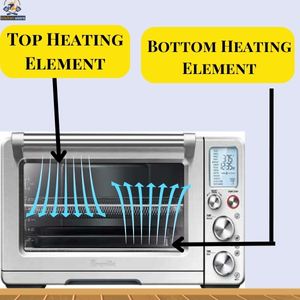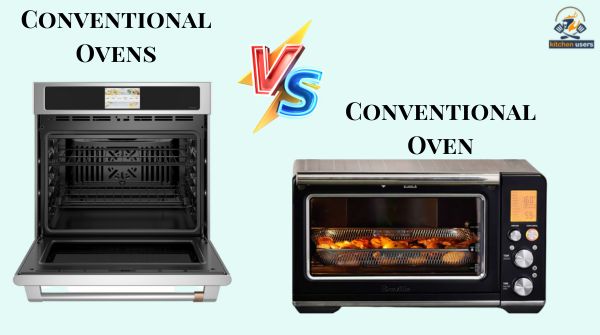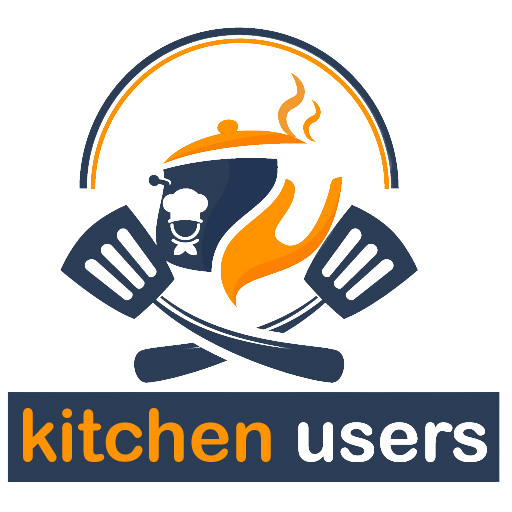Convection and conventional ovens are important kitchen tools for baking, roasting, and broiling. Although they have some similarities in function, they have distinct differences in how they heat and produce results. In a survey, we found that many users don’t know the difference between convection and conventional ovens. We have even seen many users who can’t make the right decision due to not knowing the difference between the two. So, we will share with you, from our many years of experience, the main difference between convection and conventional ovens.
So, let’s start!
The Convection Ovens and their Features

A convection oven has a fan and exhaust system that move hot air around the oven space. Look at the image; we are trying to show you how the convection oven fan works. This keeps hot spots from growing and evens out the cooking on different racks. Certain convection ovens have a third heating element known as true convection. This element helps food cook quicker by spreading hot air around the sides, bottom, and top. They are great for baking and cooking meat, and you might not even have to turn your food around in the oven.
When using a convection oven, remember that the recipe’s times and temperatures may need to be changed. The temperature of your oven might not be right if you notice it. It might need to be adjusted before you use it. A convection conversion option on some Whirlpool® gas and electric convection ovens works. You don’t have to do anything to change the cooking time and temperature for your next meal.
Features:
- The fan circulates hot air throughout the oven cavity
- Better than regular oven at cooking food faster and more evenly
- Produces food that is crispier and more evenly browned
- You can use it for many cooking tasks, like baking, roasting, broiling, and dehydrating.
The Conventional ovens and their Features

A conventional oven, also known as a traditional or regular oven, is found in many homes. It has two heating elements that heat the air inside the oven, such as:
- Bottom heating element
- Top heating element
These heating elements are typically made of nichrome wire, a type of metal alloy resistant to heat and corrosion.
The main source of heat comes from the bottom heating element. Look at the image we are trying to show you how heat is generating from the bottom. It’s excellent for roasting significant cuts of meat, such as turkey or whole chicken. The top heating element gives intense heat from above and is ideal for broiling and browning casseroles. The middle rack is usually where casseroles and baked goods go in the oven.
The top heating elements are responsible for browning and broiling. The bottom heating element is located at the bottom of the oven cavity. It is typically used for baking and roasting. When the bottom heating element is turned on, it heats up and radiates heat upward. This heat cooks the food from the bottom up.
Here are some of the features of a conventional oven:
- Uses heating elements to cook food
- Cooks food more slowly than convection ovens
- Can sometimes cook food unevenly
- Less expensive than convection ovens
4 Differences between convection and conventional ovens
Below, we are sharing resarchful differences between convection and conventional ovens
Energy efficiency
At the time of our research, our team noted that “Appliance Science” Published an article. It has been said, “When cooking food in a convection oven, it cooks around 25% faster than in a conventional oven. Do you know how?
Actually, like an air fryer, convection ovens have a fan that moves the air around inside the oven. The fan sucks air from one area, usually the back, and blows it back into the oven at the top. This movement balances the room temperature and cooks food faster by increasing hot air contact. Even the journal Food Science says that a convection oven can cook faster. On the other hand, a conventional oven (regular or traditional) also takes longer to preheat.
Oven Capacity
Conventional ovens’ capacity: Most conventional ovens have a size between 0.7 and 5.0 cubic feet. Some are smaller, and some are larger. The capacity determines how many dishes can be cooked at once and what size cookware can be used.
Convection Oven Capacity: Convection ovens are usually the same size as regular ovens. Countertop models range from 0.5 to 2.0 cubic feet, while range ovens can be 5.0 cubic feet or bigger.
Heating element
The heating element is a key factor that sets convection ovens apart from conventional ones. Most Conventional ovens have heating sources on the top or bottom. Although we have tried to explain it to you above with pictures. These elements cook food by giving off direct radiant heat. Convection ovens, on the other hand, not only have these heating elements but also feature a fan. This fan moves hot air around the food, making the cooking process more even and faster. Convection ovens cook food better because they use radiant heat and circulating air.
Heat Distribution
Heat in regular ovens comes from heating elements at the top and bottom. The hot air goes up from these things and makes the oven get hotter in some places than others. The oven can have hotter parts near the heating elements and cooler parts in the center. As a result, food cooks unevenly, with some parts becoming overcooked while others remain undercooked.
Convection ovens solve this problem with a fan that circulates hot air in the oven. This continuous airflow ensures that all areas of the oven receive consistent heat. The fan also helps remove moisture from the food, making it brown and crisp faster.
Comparison Table Between Convection And Conventional Ovens
| Feature | Convection Oven | Conventional Oven |
| Cooking Speed | Faster cooking times due to even heat distribution | Slower cooking times due to uneven heat distribution |
| Preheat Time | Shorter preheat time due to efficient heat circulation | Longer preheat time due to slow heat diffusion |
| Baking Results | Provides even browning and crisping. | Uneven browning may require rotating dishes for even cooking. |
| Suitable Cooking Methods | Roasting, baking, broiling, and dehydrating | Baking, roasting, and boiling |
| Cost | More expensive than conventional ovens | Less expensive than convection ovens |
| Common use | Popular in professional kitchens and among serious home cooks. | Standard in many households; widely used for basic cooking needs. |
| Moisture | Quick moisture removal for dry, crispy results, great for meats and baked goods. | Slower moisture release, suitable for dishes needing more moisture, like stews and certain baked goods. |
Hopefully, from the above table, you know the differences now.
Conclusion
Convection oven and conventional ovens differ in how they heat food, affecting cooking results. Convection ovens have a fan that spreads heat evenly, making meats and baked goods dry and crisp. On the other hand, conventional ovens, lacking a fan, exhibit slower moisture release. In the end, the oven you choose depends on how you like to cook and what you plan to make.
Read more: 10 Best Small Toaster Ovens for RV [Powerful Compact Vans 2023]
As a 10 years veteran in the culinary industry, I have developed a passion for all things kitchen. With a deep understanding of food preparation and cooking techniques, I am a true kitchen specialist. My experience working in Khedmot kitchen has allowed me to hone my skills and become an expert in creating delicious and visually appealing dishes.
I am a creative and innovative chef, constantly experimenting with new ingredients and cooking methods to bring unique and memorable dining experiences to my customers. In addition to my culinary expertise, I am also highly organized and able to effectively manage a team of kitchen staff, ensuring that all tasks are completed efficiently and to a high standard.
I am dedicated to my craft and always strive to create exceptional dining experiences for my customers. Whether it’s developing a new menu, training my kitchen team, or working with local suppliers, I am always looking for ways to improve and take my kitchen to the next level.
If you’re looking for a skilled and passionate kitchen specialist, look no further. I am eager to bring my expertise to your team and help take your kitchen to the next level.



1 thought on “What Are The Difference Between Convection And Conventional Ovens”